An Italian and a German walk into a bar… wait, Let there be no filthiness nor foolish talk nor crude joking, which are out of place, but instead let there be thanksgiving. Ten years ago, two serious new players from Europe appeared on our shores, intent on upsetting the 1000 cc Japanese applecart. “Inhaling slower bikes like the way an ’84 Seville’s radiator grill consumes flies,” these intoxicatingly fabulous sportbikes – especially the winner of this epic contest – reset the course to where we find ourselves today, which is to say, without a Literbike Shootout. So far anyway. But remember: Whoever is slothful will not roast his game, but the diligent man will get precious wealth. Amen. Wait, what?
The performance of modern literbikes may be intoxicatingly fabulous, but we were becoming a little bored in recent shootouts by having to resort to splitting hairs among the Big Four’s similarly spec’d 1000cc sportbikes. Yamaha gave us a taste of something different last year with the crossplane-crankshaft version of the R1, but it has a small power number and a large weight number, so it wasn’t the game-changer we hoped would shake up the literbike pecking order. We began to feel a yawn coming on.And that’s why we’re glad 2010 has rolled around, as it sees the introduction of two totally new four-cylinder superbike contenders. Aprilia comes to the party with the first liter-sized V-Four sportbike, while the tech-heavy Germans at BMW present the most powerful production literbike ever, the S1000RR.
|
|
Promises. Promises.
At the end of 2009 we started the ball rolling early for our 2010 literbike showdown, pitting a trio of Euro superbikes – all of which are powered by some variant of the Vee engine configuration – against one another. The Aprilia RSV4 Factory came out as our fave over the Italian Stallion Ducati 1198S and KTM’s formidable and refreshingly different RC8R.
At the end of the Euro literbike mêlée we stated our intent to take the V-4 Aprilia, winner of Phase 1 of the Literbike Shootout, and pair it up to the champ of the inline-Four combatants (Phase 2) for what would have ultimately been a three-part, best of the best-type series.
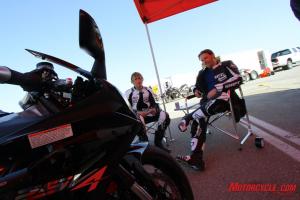 Kevin and Pete ponder how the Aprilia RSV4 R mixes with a gaggle of inline-Fours.
Kevin and Pete ponder how the Aprilia RSV4 R mixes with a gaggle of inline-Fours.
However, the anticipation was killing us, and when we were able to pop loose an RSV4 sooner than expected, we tossed our projected plan out the window.
So we threw our Vee-engine winner, the exotic RSV4 Aprilia, into the inline-Four battle. The Suzuki GSX-R1000 and Yamaha R1 remain unchanged for 2010, and since they didn’t win last year, there was no reason to expect a different result this time around.
Honda’s CBR1000RR took our literbike crown two years running and received some subtle tweaks for 2010 you should read about here, so it got an automatic invite.
Kawasaki’s ZX-10R also did well in our previous shootout, plus it received several updates for 2010 including new bodywork and a slicker-shifting transmission. Get the lowdown by reading this review.
Meanwhile, the biggest news in inline-Four sportbikes is undoubtedly BMW’s new S1000RR. After sampling the uber-powerful S1000 on its own at its press launch in Portugal, we were anxious to ride it in the company of its peers to find out how the German machine stacks up.
In this shootout, we were able to test the standard RSV4 R rather than the pricey RSV4 Factory we previously sampled. The R model is more closely spec’d (and priced!) to the inlines. The Factory’s use of Öhlins suspension all around, lighter forged-aluminum wheels, variable length intake tracts and a smattering of load-lightening carbon bits are what account for the hefty $5000 gap over the R model’s $15,999 tag.
During the 1198S vs. the KTM RC8R vs. the RSV4 Factory contest, the choice of the upscale Factory made sense when comparing the similarly equipped Duc and the equally premium KTM. But in this final battle of the 2010 liter sleds, the R model was the right choice. And that the R model makes the same peak rear wheel horsepower as the Factory means that the heart of the RSV4 experience remains intact.
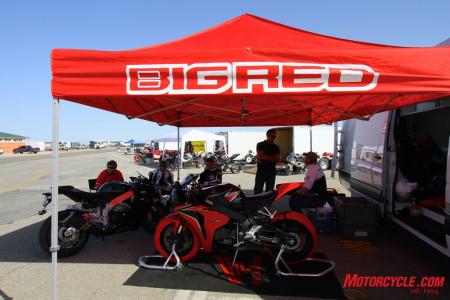 |
ENGINE
BMW plays by the rules but raises the stakes, big time!
There isn’t a bike here that doesn’t have enough engine. Running all four machines on the notoriously stingy DynoJet at Carry Andrew’s Hypercycle revealed that the lowest rear wheel hp figure recorded was a formidable 149 ponies, a tie between the Honda and Aprilia. One hundred forty nine bloomin’ horsepower! And that’s the small number. The Green Machine churned out 153 hp; nothing less than impressive.
Three of the four scoots essentially made 150 hp, and that is simply more than most of us could ever need. But BMW was about to bring the pain. Our jaws dropped as an astonishing result of 175.8 horsepower blipped across the dyno’s computer screen.
|
|
BMW purposely played by the book when building the mighty S1000RR, as it knew in order to be competitive this was no time to reinvent the superbike wheel. The S1000RR’s most significant deviation from the reliable inline-Four formula is its substantially oversquare bore and stroke when compared to the Japanese makes.
The CBR1K and ZX-10R bore and stroke numbers are really mirror images (76.0 x 55.1 and 76.0 x 55.0mm), while the GSX-R1000 hedges more stroke with 74.5 x 57.3mm. And Yamaha’s R1 crossplane crank configuration moved in the more oversquare direction (78.0 x 52.2mm) last year than the previous generation R1 (77.0 x 53.6mm). The RSV4 R’s 78.0 x 52.3mm is basically an identical twin figure to the 2009-‘10 R1.
But none of them come close to the Beemer’s oil can-size tubes. The S1000RR’s 80.0 x 49.7mm short, fat cylinders indicate a high-revving, top-end power-favoring layout. Mission accomplished. The German brand’s first-time effort in this market has it flying head and shoulders above the Big Four – as well as the rest of the European marques earnestly contesting the liter class – in the very important horsepower contest.
|
|
Even a blind dog could see the advantages of the S1K’s horsepower domination. The BMW gobbled up with ease the long front straight on the Big Track at Willow Springs International Raceway, inhaling slower bikes like the way an ’84 Seville’s radiator grill consumes flies. “The front end wanted to come up cresting Turn 6, and would have kept coming up if I’d not backed off the throttle,” remarked recent addition to the MO staff, Jeff Cobb, “It was also very light at over a buck-twenty-plus when exiting Turn 9 and while accelerating down the front straight.”
Krusty Kevin, a jaded journo rarely impressed by much these days, was stunned, too, by the BMW’s big power. “Coming onto the front straight a couple of times at a clip that seemed as fast as on the other bikes, I realized I wasn’t even using full throttle, such is its enormous top-end wallop.”
But even in the power-hungry U.S. motorcycle market we must realize that bikes are about more than just peak power found on a spec sheet. Engine character – the way a mill develops power – is equally as important as posting balls-of-brass dyno results. And in light of this reality we start to see some resistance from the old guard.
Despite a 25 hp deficit to the BMW, the virtually unchanged for three years CBR refuses to yield any ground to the new Beemer. It has a clear advantage in power against its rivals nearly everywhere below 11,000 revs.
|
|
It is a matter of fact that the Honda made the most torque over the broadest range and, more importantly, made the best use of that grunt. Aside from a strange dip (a notable drawback on the street) starting around 3300 rpm that clears up ‘round 4500 rpm, the CBR has it all over the other three from that point by several ft-lbs ‘til around 10,700 rpm when it finally relents to the BMW’s top-end biased mill.
The Honda dominates the torque game for a spread lasting at least 5000 rpm, and it does so right where it matters most: the middle. At 7500 revs, it’s making an extra 12 ft-lbs over the V-4 Aprilia, and there are several points in the rev range at which the CBR is making 10 ft-lbs more than the others.
On a racetrack with short sprints between corners, and in slow, low-gear turns, the Honda holds its own against the BMW. However, where the Honda’s middle power pays dividends is on the street, the place most literbike owners play.
The Honda’s strong, usable midrange and good throttle/fueling response are just a couple of the things that led us to dub the CBR1000RR with the unofficial title of Favorite Street Bike in this contest. But in terms of best horsepower bang for the buck and biggest grin maker, the BMW rightfully belongs at the top.
|
|
It ain’t easy bein’ green. Kawi might share that sentiment with Kermit this year. The ZX’s problem isn’t that it has any problems, but more that it doesn’t particularly stand out in the Class of 2010.
It still makes crazy power, and it develops that power with relative ease; it was surprising how quickly the shift light came on or redline arrived, as the ZX’s mill spins up quickly. There’s a fun poke of power around the 9K rpm area, right where the Zed hits peak torque. Otherwise, it’s nothing but smooth, linear power from the Kawasaki.
What’s to complain about with the Ninja? Nada. What’s to get super excited about? Well, let’s just say there’s heaps to like about the Kawasaki’s ferocious engine. Alas, it finds itself in the same subservient position to the Honda’s grunt as it did last year, and of course it, too, is down to the BMW in overall power.
The Aprilia RSV4R finds itself in a similar situation as the Kawasaki: plenty of power just about everywhere, but not quite as much as the ZX and not the same fat midrange as the Honda. It also sees a 25 hp deficit to the Beemer.
We love the raucous exhaust note the V-4 produces, sounding akin to a sprint car race motor, but we wonder how its muffler got past the EPA. “I wouldn’t want a bike any louder than this,” said Kevin, “but this could be the most wonderfully musical motorcycle engine in history.”
|
|
The RSV4’s throttle response in Track mode is borderline abrupt, so the smoother Sport mode is a better choice when transitioning between corners while modulating the throttle at small openings during canyon riding. On the racetrack, we preferred the sharper response of Track mode.
In a similar theme, the Beemer’s ultra-performance Slick mode setting made for equally snatchy on-off throttle response while street or canyon riding. We preferred the Race setting even on the track, while on the street the Sport setting provides smooth yet potent responses. We’re happy to report no climatic need to try the Rain mode.
CHASSIS PERFORMANCE
Sharp tools in the shed
Despite its tall seat, the RSV4 feels smaller and packaged tighter than the others. Aprilia’s mass-centralization efforts found in fuel carried partially under the seat and a compact V-4 engine lend to the sensation the bike is more akin to a 600 in terms of rider triangle and weight.
Centralized mass also masks the Aprilia’s heaviest-of-the-bunch measured wet weight of 470 pounds. Kevin felt that, despite the weight, a rider can flick it confidently into the corners. “The RSV4 feels very compact, boosting confidence that you can make the bike bend to your will.” Like the Factory model, the R model possesses excellent stability and good feedback from the front end. However, the RSV’s heft made itself known in the face of bikes that were lighter – one significantly so.
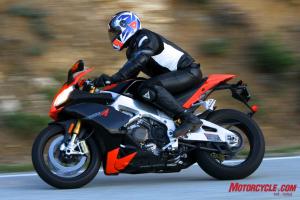 Despite the RSV4 R and Factory’s compact rider triangle, resident tall(ish) guy Jeff learned to love all that the Aprilia had to offer in terms of its handling, braking and powerful V-4 engine.
Despite the RSV4 R and Factory’s compact rider triangle, resident tall(ish) guy Jeff learned to love all that the Aprilia had to offer in terms of its handling, braking and powerful V-4 engine.
Our RSV4 R suffered a flukey electrical issue when the gear-position sensor wire grounded out after its insulation had been melted by the rear cylinders’ exhaust headers. Aprilia techs assure us they’ve never seen this problem before.
To enable us to continue our test with minimal interruption, Aprilia quickly replaced the R with an RSV4 Factory (the only version available at the time) midway through one of our rides. This gave us an excellent opportunity to compare the R to its expensive brother.
It quickly became apparent just how important a role weight savings plays in this highly competitive class. Recall that the Factory comes with lighter forged wheels in contrast to the R model’s cast-aluminum hoops. On paper, forged wheels look only to raise a bike’s price tag, but in reality the advantages are significant. The Factory was much more easily hustled through series after series of tight turns than was the R model.
“Wow, what a difference! Its lighter wheels make a huge improvement to steering and handling,” said Kevin after riding a Factory shortly after getting off the RSV4 R.
Shaving weight anywhere will pay dividends, but if you’re going to trim the fat, wheels are the best place to start in order cut down on rotating mass.
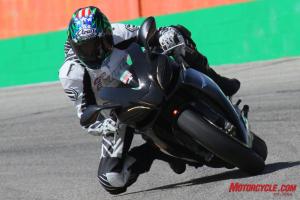 Kevin enjoying the Aprilia’s planted chassis and confidence-inspiring front-end feel.
Kevin enjoying the Aprilia’s planted chassis and confidence-inspiring front-end feel.
The ZX-10R (458 lbs measured wet) isn’t as plump as the Aprilia, but it’s still heavier than the remaining two. Perhaps more important to the ZX’s handling though is its comparatively mild steering geometry. Steering rake of 25.5 degrees and trail of 4.3 inches is the laziest of the group. The Priller’s rake is a whole degree steeper (24.5) than the Zed’s, and it has slightly less trail.
In a group where there truly isn’t a slow steering bike, the ZX’s geometry is the only thing we can point to that prevented it from feeling as nimble as the Honda or BMW. “It feels balanced in the corners, but it seems less wieldy than the others in this elite club,” noted Kevin.
It’s worth noting we had a more favorable impression of the Ninja’s handling in last year’s shootout, which was equipped with an accessory 6mm shim for the shock that raised the rear ride height 12mm (a 2-to-1 ratio), thereby making the steering rake angle sharper and influencing the swingarm down-slope. Wanting to test stock to stock this year, we opted to run it without shims and didn’t like it as much. If we owned a 10R, we’d definitely experiment with shims. Kawi dealers can order a “spacer set” that is an assortment of five shim sizes that can be used in combination for a variety of options. But if you don’t like its $87.96 retail price, a suitably sized washer could be substituted.
The ZX feels physically larger than the others, as it has a very roomy saddle-to-clip-on relation, and the second tallest seat height of 32.7 inches (the racy Italian RSV sits the tallest with a seat height of 33.3 inches). For those of you larger than a jockey, the big Ninja could be the right literbike. Six-footer Jeff was pleased with the ZX’s roomy rider accommodations.
“The ZX had the best ergos for my height, and I would speculate up to 6’4” riders, maybe taller,” said Jeff. However, Jeff, like Kevin, noticed that the ZX wasn’t as scalpel-like as a couple of the others in terms of steering effort or response. “It took more effort to hold a line, but not too much to be a bother, and the bike wanted to stand up while trail braking.”
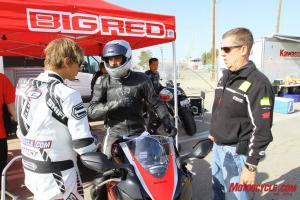 “The CBR’ll go pretty good ‘round corners ya say?”
“The CBR’ll go pretty good ‘round corners ya say?”
The BMW’s ergo package is very similar in feel to the RSV. It’s a literbike that fits and even looks like supersport size. “Another solid-feeling chassis that remains composed no matter how hard it is pushed, accompanied by plentiful feedback and without any handling bugaboos,” said Kev.
Its 23.9-degree rake is racy, but even racier is the Honda’s 23.3-degree steering rake. The CBR and S1K have similar trail figures of 3.8 and 3.7 inches respectively. Both motorcycles provide a responsive chassis and yet both motorcycles have excellent composure despite feathery steering. As willing a participant as the BMW is to any of the rider’s steering input, the CBR is even more responsive, to the point that it feels as though the Honda anticipates the direction in which you wish to go.
Working in the Honda’s favor is its measured wet weight. At 437 full of crucial fluids, it’s a full 16 lbs lighter than the next lightest BMW that scaled in at 453 pounds fueled up and ready to go.
“With the lightest weight and sporting the most aggressive steering geometry, it’s no surprise the CBR is the agility champ,” Kevin stated. “It’s only in high-speed stuff – when its electronic steering damper automatically cranks up – that it steers heavy.”
|
|
As much as we enjoyed getting reacquainted with the CBR on the track, we were reminded even more how much we liked it when ridden on public roads. With less demands on the steering damper when ridden at street pace, the Honda’s user-friendly chassis is all the more impressive for its light steering response and linear transition from upright to full lean. For a literbike with this much power, the CBR proves exceptionally easy to ride in all environments.
BRAKES
Stop it!
BMW has the best set. Period. Exceptional levels of feel and power; even at 120-plus mph it only takes one finger to reel the German screamer in, and the chassis remains stable the whole time. Along with producing game-changing power in the S1000RR, BMW also has set a high mark in braking, the new standard by which all other liter bikes will be judged.
“Best in class,” raved Kevin. “It’s amazing how well they work considering the Brembo calipers are the supposedly lesser grade two-piece units than the more fashionable monoblock calipers used on other high-end machines.”
The Honda’s binders offered very good feel and initial bite, but as satisfying as the red bike’s brakes were, they’re still not in the same league as what is found on the BMW. It’s a similar story with the gold Brembo monoblocks on the Aprilia. The RSV4’s binders are quite impressive, really, but even they’re not the same caliber as the BMW’s.
|
|
It’s hard to believe we’re saying this, but the ZX-10R’s brakes just don’t measure up in this crowd. Boy, how times have changed!
The Kawi was once the leader in the stopping department, but in comparing its brakes to the others, the ZX’s have a soft-ish initial bite and lack the degree of sensitivity found in the other brake sets. It’s weird to make such remarks about the ZX’s brakes, ‘cause they are still excellent. Nevertheless, this is how the literbike game is played every couple years.
SUMMARY
Our street riding and a day of high-speed flogging at the track revealed a quartet of literbikes with distinct personalities.
Slight tweaks to a solid platform have resulted in the best ZX-10R ever produced. Add to an explosive and invigorating engine excellent fork compliance, great brakes, a super-slick transmission and perhaps the best slipper clutch of the bunch, and the Ninja still holds its own in this superior group. It also has the most attractive MSRP, ringing in $3000 cheaper than the less-powerful Aprilia.
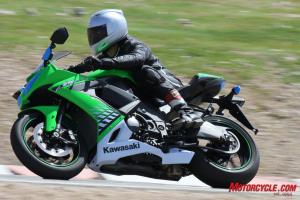 Once near the top of the heap only a year ago, the ZX-10R found itself out of contention for our favorite literbike in 2010. Really, though, picking up a 2010 ZX-10R could be one of the best motorcycle-related decisions of your life if you’re a Team Green loyalist. It’s the best 10R yet.
Once near the top of the heap only a year ago, the ZX-10R found itself out of contention for our favorite literbike in 2010. Really, though, picking up a 2010 ZX-10R could be one of the best motorcycle-related decisions of your life if you’re a Team Green loyalist. It’s the best 10R yet.
Ah, the Aprilia. Of this group, the V-4 Italian superbike tugged strongest at our heartstrings. “The RSV4, more than any other bike here, makes its rider feel like something special,” said Duke. “This is the literbike to be on if you’ve got a low score on HotOrNot.com.”
And yet, as seductive as the ‘Priller is, the ultimate battle in this war shaped up between the fresh BMW and the established Honda.
When BMW released initial details on the S1000RR in May of last year, and we then got up close and personal for the first time with the S during the U.S. round of WSBK at Miller Motorsports Park, we suspected this new literbike would be a worthy contestant. Additionally, when Kevin attended the bike’s world unveiling in Portugal last year we started to get a sense of how well the S might perform against the other bikes in the class.
But it wasn’t until this comparison review that we fully understood just how flippin’ great the new Beemer is!
However, it wasn’t a black and white thing, as the venerable CBR1000RR stood strong. The Honda’s renowned midrange power makes it one of the most user-friendly literbikes yet created; its brakes are more than capable; and, well, it should be obvious at this point, but it’s worth singing the praises, one more time, of the CBR’s overall chassis performance.
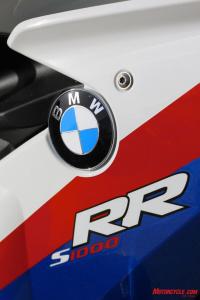 BMW S1000RR. If you want the literbike with the most power, best brakes, a wonderfully compliant chassis and best available options in 2010, these are the only letters and numbers you need to know.
BMW S1000RR. If you want the literbike with the most power, best brakes, a wonderfully compliant chassis and best available options in 2010, these are the only letters and numbers you need to know.
The Honda, although hardly changed much in the past three years, seemed always nipping at the BMW’s heels. Yet, as solid as the bike from Big Red is, it simply isn’t all that the S1000RR is.
With a base MSRP of $13,800 the BMW is a mere $401 more than the standard model CBR. How many people have spent double that difference, and then some, trying to gain an extra 10 or so ponies?
Would you spend 400 clams to get another turn-key 25 horsepower? We’re guessing a lot of folks in the market for a 2010 literbike would gladly eBay that rarely used set of golf clubs or something to cover the marginal difference in MSRPs.
Give the CBR its only available option of C-ABS, and the Honda’s retail goes up $1000 to $14,399.
For an extra $1480 over the BMW’s standard price, a Beemer buyer gets ABS and BMW’s Dynamic Traction Control (DTC). And let’s not forget the BMW also has four engine mapping modes that the bike’s brain seamlessly integrates with the ABS and DTC to make for an electronics package heretofore unseen on a consumer-available literbike. This impressive and practical e-package bumps the Beemer’s tag by only $881 more than the C-ABS-equipped Honda’s price, and it’s still less than the RSV4.
Perhaps we didn’t find the BMW’s handling quite as lovely as the Honda’s, but it was still about 9/10ths of what the Honda offered. Factor in superb braking, an extra 25 hp, all the highly effective electronic rider aids, and the new BMW is the bike to beat in 2010.
| Notes, observations and musings | |
| • The Aprilia in this test, as well as the RSV4 we had at the end of last year, routinely registered below 30 mpg, while the other bikes averaged 35 mpg or more at times. | |
| • Although none of the liters have especially good mirrors, the CBR’s offer the best field of view. | |
| • The CBR is still the only bike without a fuel gauge or gear position indicator. | |
| • Each of the BMW’s compression and rebound adjuster positions (adjustable with the ignition key!) are numbered 1-10. Most other suspension systems have you listening for and counting clicks like a thief trying to crack a safe. | |
| • Measured wet weights: CBR – 437 lbs, BMW – 453, ZX – 458, RSV4 R – 470 | |
| • According to a report in Sport Rider, the RSV4 Factory’s wet weight (462) reveals an 8 lbs savings over the R model we weighed. | |
| • Regular guest tester and owner of exotic motorcycles, Kaming Ko recognizes a good motorcycle when he sees and rides one. “The Honda CBR1000RR is still one of my all-time favorite bikes,” he said reassuringly. “If I were to buy an everyday sportbike, I would pick the CBR. But, the good news is my lovely wife says I can have two! So, I may have to add the BMW S1000RR to my list!” | |
Related Reading
2010 Literbike Shootout: Aprilia RSV4 Factory vs. Ducati 1198S vs. KTM RC8R
2009 Literbike Shootout
All Sportbike Reviews on Motorcycle.com
All Things Aprilia on Motorcycle.com
All Things BMW on Motorcycle.com
All Things Honda on Motorcycle.com
All Things Kawasaki on Motorcycle.com
S1000RRforum.com
1000RR.net
ZX-10R.net
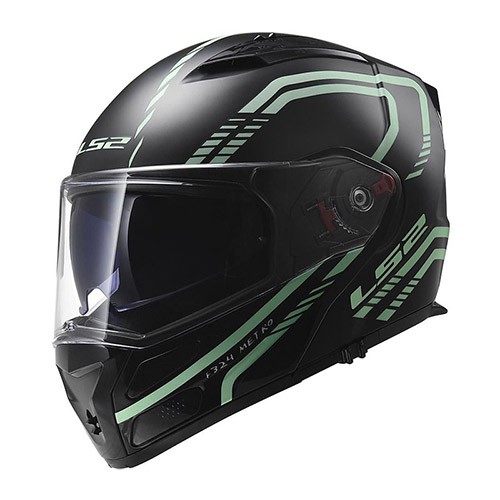
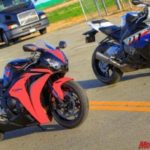
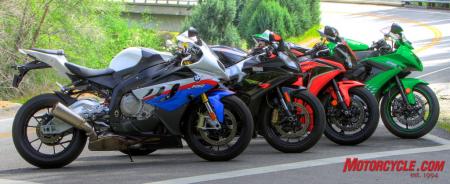 Japan vs. the Euros: 2010 BMW S1000RR, 2010 Aprilia RSV4 R, 2010 Honda CBR1000RR and 2010 Kawasaki ZX-10R.
Japan vs. the Euros: 2010 BMW S1000RR, 2010 Aprilia RSV4 R, 2010 Honda CBR1000RR and 2010 Kawasaki ZX-10R.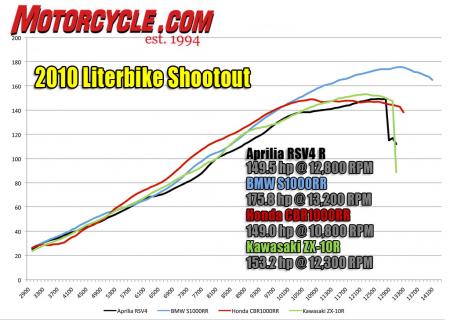 The S1000RR is the new Horsepower King, but note how its big-bore/short-stroke motor trades some low-end grunt for its screaming ability up top.
The S1000RR is the new Horsepower King, but note how its big-bore/short-stroke motor trades some low-end grunt for its screaming ability up top.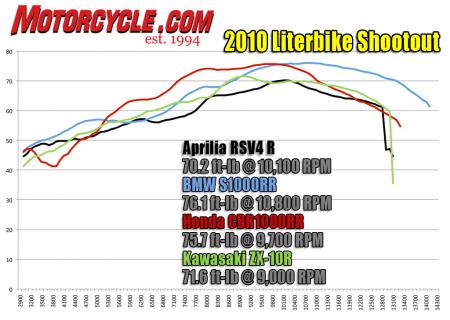 The new Beemer may be the uncontested horsepower champ, but note how the CBR dominates the midrange game. Its strong, usable grunt advantage spans a range of approximately 6000 rpm! Note also how the supposedly torquey V-4 Aprilia lags behind the others and how the ZX-10R mostly outperforms the class newcomers.
The new Beemer may be the uncontested horsepower champ, but note how the CBR dominates the midrange game. Its strong, usable grunt advantage spans a range of approximately 6000 rpm! Note also how the supposedly torquey V-4 Aprilia lags behind the others and how the ZX-10R mostly outperforms the class newcomers.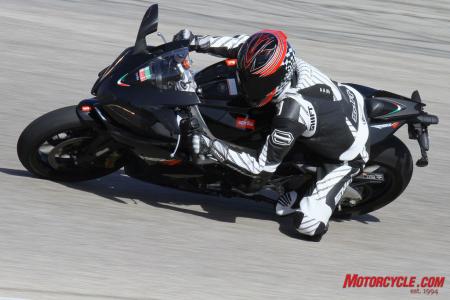 The RSV4 R, like the Honda, is down on peak horsepower big time to the S1000RR, but the Aprilia’s compact feel and centralized mass equate to a bike that’s easy to flick confidently into the corners.
The RSV4 R, like the Honda, is down on peak horsepower big time to the S1000RR, but the Aprilia’s compact feel and centralized mass equate to a bike that’s easy to flick confidently into the corners.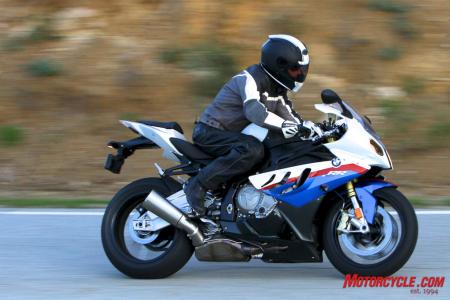 The white, red and blue Motorsports color scheme for the S1000RR is available for an additional $750.
The white, red and blue Motorsports color scheme for the S1000RR is available for an additional $750.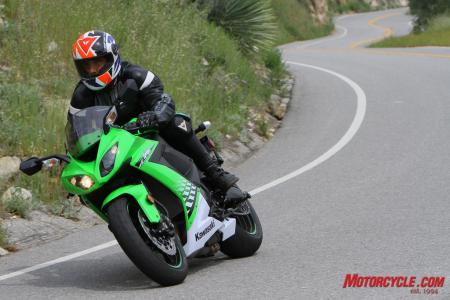 Six-footer Jeff appreciated the Big Ninja’s roomy ergo package. Tall riders take note.
Six-footer Jeff appreciated the Big Ninja’s roomy ergo package. Tall riders take note.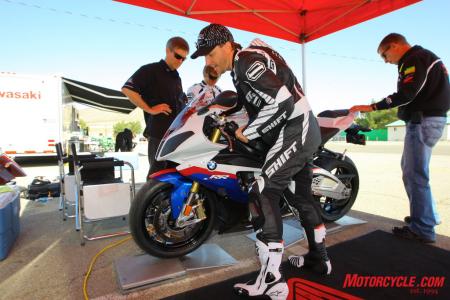 “This thing’s gotta weigh at least 453 pounds.”
“This thing’s gotta weigh at least 453 pounds.”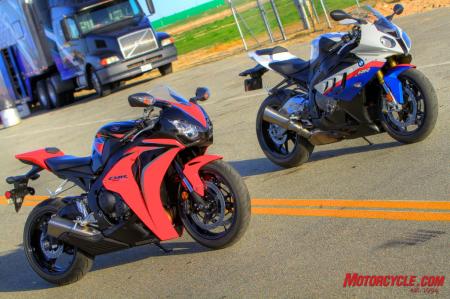 Each bike in this four-way battle for the 2010 Motorcycle.com Annual Literbike Shootout are excellent choices for anyone in the market for a new 1000cc sportbike. However, near the end of our evaluation it was becoming clear that either the Honda or BMW would eventually emerge as the overall champ.
Each bike in this four-way battle for the 2010 Motorcycle.com Annual Literbike Shootout are excellent choices for anyone in the market for a new 1000cc sportbike. However, near the end of our evaluation it was becoming clear that either the Honda or BMW would eventually emerge as the overall champ.